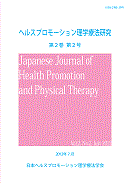Volume 6, Issue 2
Displaying 1-7 of 7 articles from this issue
- |<
- <
- 1
- >
- >|
ORIGINAL ARTICLES
-
2016Volume 6Issue 2 Pages 53-57
Published: July 29, 2016
Released on J-STAGE: September 28, 2016
Download PDF (377K) -
2016Volume 6Issue 2 Pages 59-64
Published: July 29, 2016
Released on J-STAGE: September 28, 2016
Download PDF (383K) -
2016Volume 6Issue 2 Pages 65-71
Published: July 29, 2016
Released on J-STAGE: September 28, 2016
Download PDF (377K)
SHORT REPORT
-
2016Volume 6Issue 2 Pages 73-77
Published: July 29, 2016
Released on J-STAGE: September 28, 2016
Download PDF (344K) -
2016Volume 6Issue 2 Pages 79-82
Published: July 29, 2016
Released on J-STAGE: September 28, 2016
Download PDF (358K)
FIELD REPORT
-
2016Volume 6Issue 2 Pages 83-88
Published: July 29, 2016
Released on J-STAGE: September 28, 2016
Download PDF (398K) -
2016Volume 6Issue 2 Pages 89-93
Published: July 29, 2016
Released on J-STAGE: September 28, 2016
Download PDF (347K)
- |<
- <
- 1
- >
- >|
